Excerpts from Jim Conrad's
Naturalist Newsletter
Entry from field notes dated June 30, 2023, taken along small gravel road about 1 km west, across valley, of El Suspiro about 1 straight-line km NW of El Doctor; in the mountains of east-central Querétaro state, municipality of Cadereyta de Montes, 12 straight-line kms due east of Vizarrón de Montes but much farther by twisting roads; elevation ~2600m (~8500 ft), Querétaro, MÉXICO, (N20.85563°, W99.58686°)
SCARLET RUNNER BEAN IN ITS NATIVE HABITAT
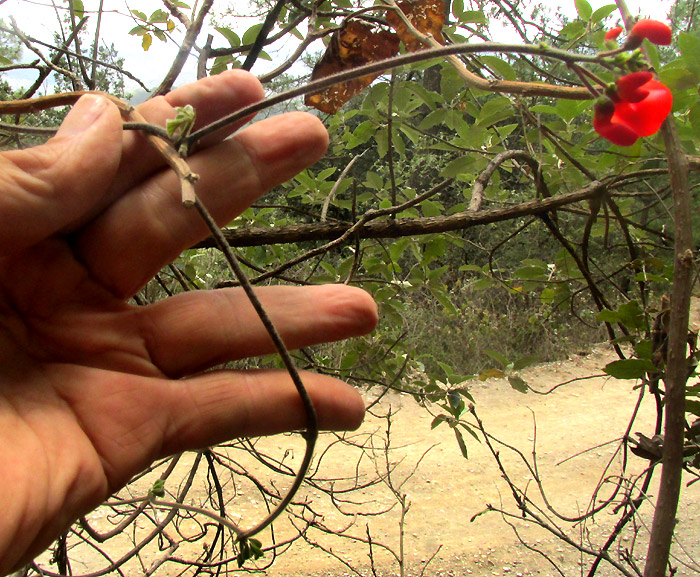
On a steep, forested slope just below a high limestone cliff, with a narrow gravel road running below it, the above vine bore racemes of red flowers on long, robust peduncles. The vine's stems didn't wrap tightly around their supports, but rather somewhat stiffly wandered through the bushes and tree branches.
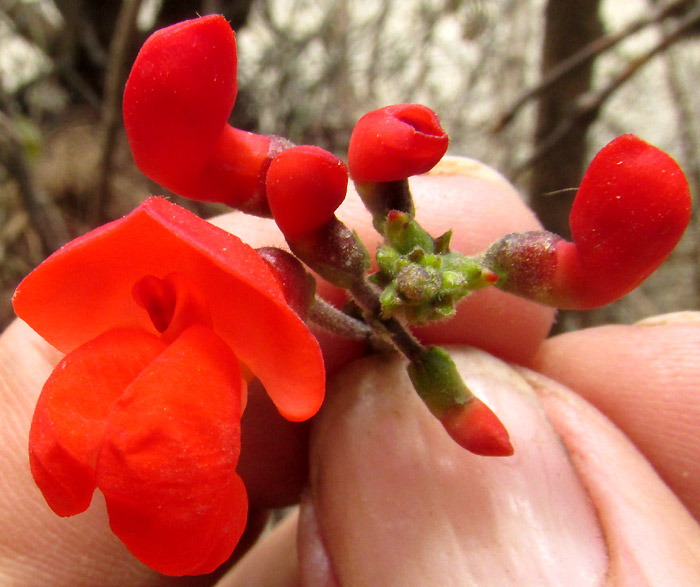
Up close, the flowers were structured along the line of typical garden bean-vine "papilionaceous" flowers: five petals, including two side-petals called wings, one petal alone named the standard or banner, and two other petals fused along their common margin to form a scoop-shaped or boat-bottom-shaped "keel." The above open flower is a little confusing, partly because the intense red color obscures certain petal features. It's clear that it has a bonnet-like standard and two side-growing wings, but the scoop-shaped keel's presence is ambiguous. Also, note that one of the wings bends to the inside. When the bent wing was removed, this became visible:

The white, curved structure is the keel, which was hidden in the previous picture. The slender, coiling keel wraps around hidden stamens and pistil. This coiled arrangement is typical of several Bean Family genera, including common garden bean vines and bushes. In the above picture, the remaining side wing adheres to the coiled keel in such a way that when a pollinator enters the blossom, pushing aside the wings, the wing tugs on the coiled keel in such a way that it moves relative to the sexual parts it encircles. This causes the stigma-tipped style to emerge from the keel, to receive pollen from the pollinator.
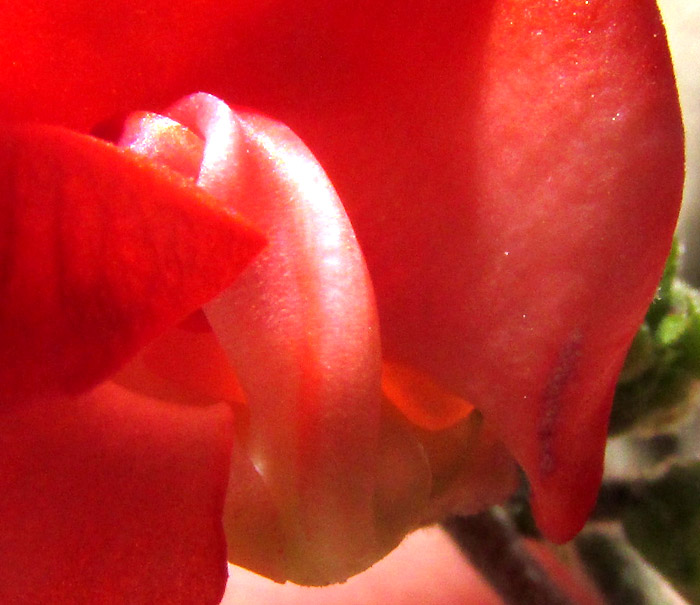
Above, the flower with the obscuring wing removed shows that the keel makes two spirals.
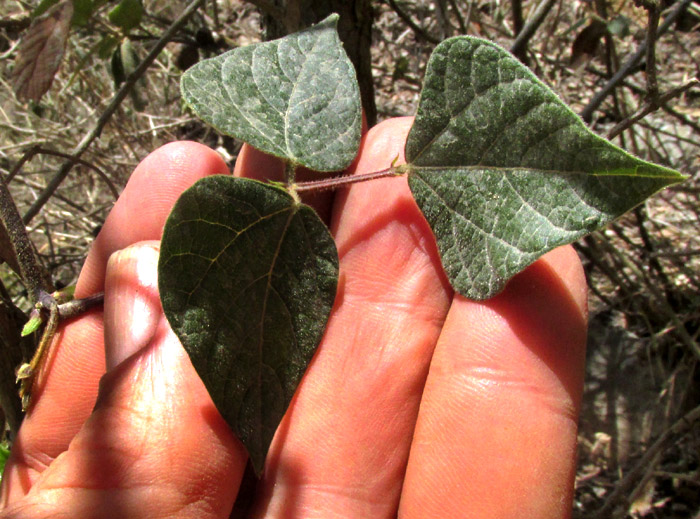
The vine produced leaves divided into three leaflets, with the middle leaflet on a relatively long stalk, or petiolule, rather like the common garden bean.

Leaflet undersurfaces were densely hairy.

Two conspicuous stipules at each petiole base gradually narrowed to slender tips, and were arranged so that they pointed in opposite directions.
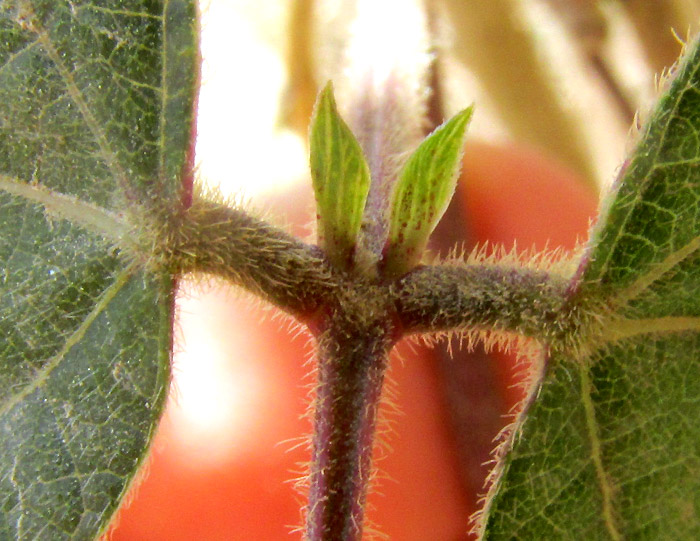
Stipule-like stipels grew at the bases of leaflet petiolules.
The above details identify a Bean Family species grown worldwide not only for its pretty flowers but more importantly as a bean-producing food crop. However, our plant isn't escaped from someone's garden or field, but rather occupies its natural habitat in its native distribution area. According to Georgina Pearman in her 2005 book The Cultural History of Plants, in the highlands of Mexico and Guatemala probably it was cultivated around 2000 BCE. Here we have PHASEOLUS COCCINEUS, known by many common names, including Scarlet Runner Bean, Runner Bean and Multiflora Bean.
The vine's immature seedpods are eaten raw or cooked, though eating too much raw can have toxic effects. Cooked mature beans are mild flavored and floury-textured; when cooked with butter, sometimes they're called butter beans, though that name more often refers to Lima Beans, Phaseolus lunatus, in the same genus. In some places even the flowers and young leaves are eaten, the leaves cooked as a potherb. The tuberous roots are rich in carbohydrates and can be cooked and eaten.
Medicinally, in Africa a decoction made from the roots is taken against malaria, and applied to swollen eyes. In the lab, a peptide known as coccinin isolated from the beans has shown antifungal activity, and has inhibited the growth of leukemia cell lines. In traditional farming at higher elevations the plant is productive when interplanted with corn, or maize.
Numerous cultivars of the species have been developed, including a dwarf one for backyard suburban gardens. However, when cultivars are created emphasizing one desirable feature, certain resistances to diseases may be lost. This has been shown in the 1997 study by Roberto Lindig-Cisneros and others entitled "Phytoalexins, Resistance Traits, and Domestication Status in Phaseolus coccineus and Phaseolus lunatus." That study concluded that "Overall, wild seedlings of Phaseolus coccineus and P. lunatus showed higher resistance to fungal infections than cultivated ones."
In other words, our wild, upland central Mexican plants constitute an important reservoir of genes providing Nature's own solutions to diseases of this very important species.
By the way, the name Phaseolus coccineus is an old Linnaeus one, announced to the scientific world in 1753, in Linnaeus's seminal Species Plantarum.
from the October 22, 2007 Newsletter issued from Yerba Buena Clinic just outside Pueblo Nuevo Solistahuacan, Chiapas, MÉXICO
about 1740 meters in elevation, ± LAT. 17° 11' 27"N, LONG. -92° 53' 35"W
BOTIL BEANS
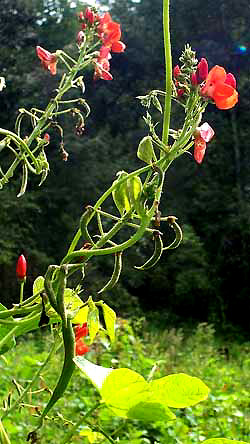 Inés's weedy field of bean vines is pretty to see especially because the bean flowers are red, as shown at the right.
Inés's weedy field of bean vines is pretty to see especially because the bean flowers are red, as shown at the right.
In North America you seldom see red bean flowers, so it's worth reflecting on the diversity of bean-plant species in general.
Regular garden beans belong to the genus Phaseolus (not soybeans, which are the genus Glycine). Of the many species of Phaseolus known, my old classic Bailey's Manual of Cultivated Plants lists twelve species commonly cultivated in North America, among which appear such well-known names as Lima, Kidney, Mung and Adzuki -- each a different species. Other species are known by such interesting names as Snail-flower, Metcalfe, Rice Bean, Moth Bean and Tepary Bean. Our most frequently planted bush and pole beans, such as "Kentucky Wonders," are considered Kidney Beans, and are Phaseolus vulgaris.
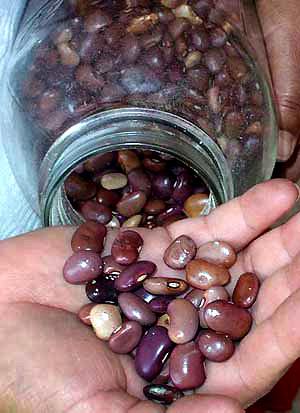
Inés's red-flowered beans key out to PHASEOLUS COCCINEUS, known commercially as Multiflora Beans or Scarlet Runners. They're native to the American Tropics. Inés calls them Frijoles Botil, or Botil Beans, Botil sounding like a native word, maybe Tzotzil. Inés harvests the beans, dries them, and stores them in big glass jars, as you can see at the left.
Notice how variously colored Botil Beans are, in contrast to the garden beans we usually plant up north. Our northern beans have been genetically selected to the point that there's little variability among them, but these native beans clearly still are lustily mixing things up, providing genetic diversity that may be behind their ability to compete with all those weeds and insects. Can you imagine what would happen to a Burpee Lima Bean planted among such rank weeds?
A neat feature of Phaseolus flowers -- a feature distinguishing the genus -- is that the blossoms' two lowest of five petals are united along one side of each petal into a scoop-like, boat-shaped "keel" and this keel is then strongly coiled. It's normal for Bean- Family flowers to have two petals joined into a keel, but this coiled feature is something special. You should look for it on bean flowers in your own garden. On some Botil-Bean flowers you can see the coiled keels knotted up in the blossoms' centers, as shown below.
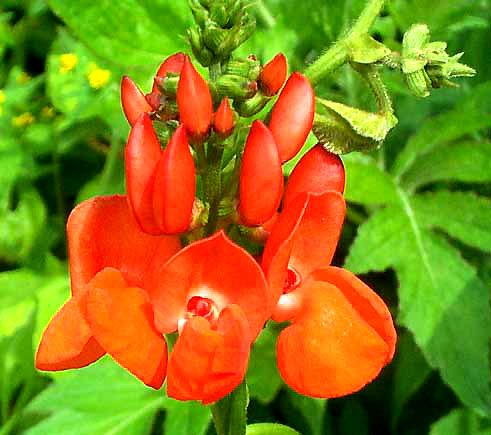
I wondered why a bean flower would coil its keel. Imagining myself to be a hummingbird approaching the flower I found that with the keel twisted to one side a hole was created beside the keel just right for inserting my beak!
>